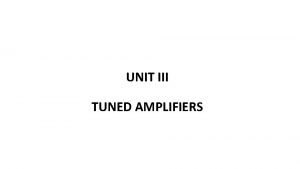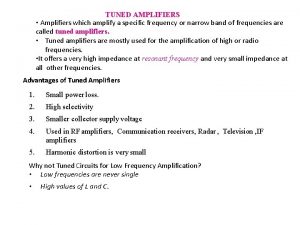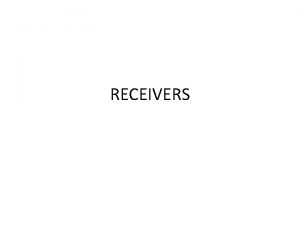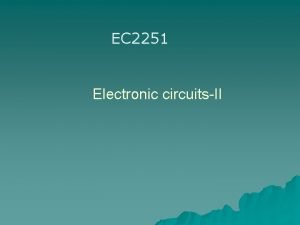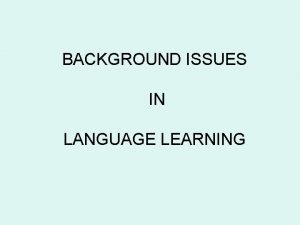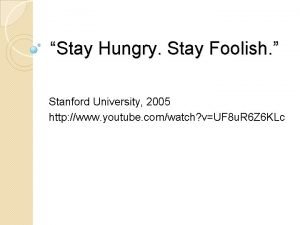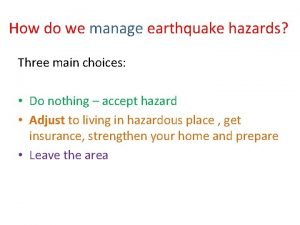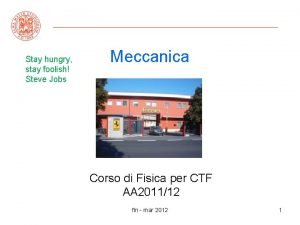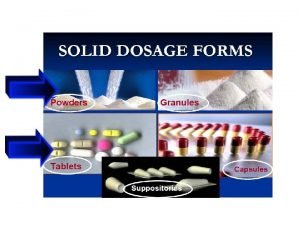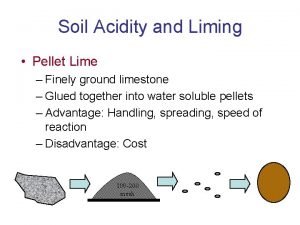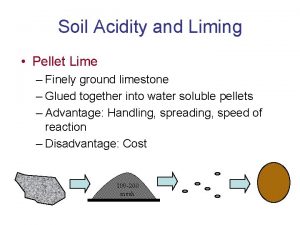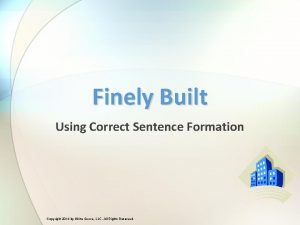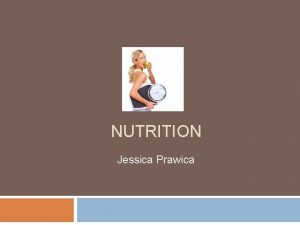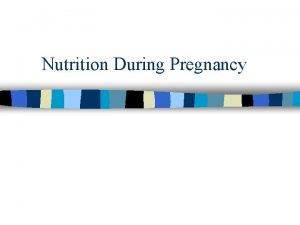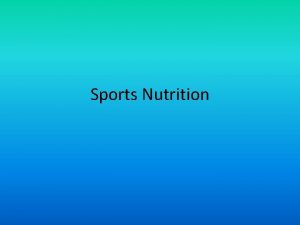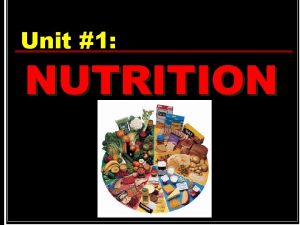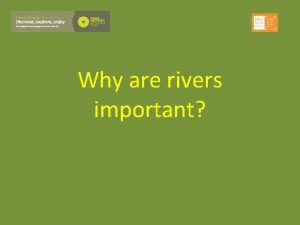NUTRITION Why is nutrition important Finely tuned a














- Slides: 14

NUTRITION

Why is nutrition important? Finely tuned, a good diet will: • decrease fat and pack on muscle • Improve physical performance • increase energy, sense of well being, mental acuity • nudge every important quantifiable marker for health in the right direction

RECOMMENDATION *Keep intake to levels that support exercise but not body fat � This recommendation is adequate to the task of preventing the scourges of diet-induced disease � more accurate and precise prescription is necessary to manage intake levels and optimize physical

Dr. Barry Sears � Biochemist, family history heart disease • Every time you eat macronutrients a hormonal response is generated which determines how much body fat you will store Hormones: Insulin: promotes fat storage Eicosanoids: “master switches”, control body functions including fat storage Balancing hormones: Helps prevent heart disease, cancer, arthritis, diabetes Help us reach optimal physical, psych, mental performance Sears found this balance can be achieved using food

• a state of optimal health, physical performance and mental alertness • tested on world class athletes, diabetics, individuals with heart disease and AIDS • results showed that dietary technology is the most powerful means to help people achieve the Zone

Problems with high protein & low fat diets High protein diets: promotes water loss vs. fat loss Cause the body to use muscle mass to convert protein into CHO for energy FAT is NOT the enemy Low-fat foods are often high in sugar You need to eat fat to lose fat Fat helps us feel full longer and aids in nutrient absorption There’s an increasing awareness that excess carbohydrates play a dominant role in chronic diseases

A closer look at carbohydrates � The Zone Diet is not a “low-carb” diet (40%) • Most Americans’ CHO consumption is 80 -85% • The culprit in obesity and related diseases is no longer seen as dietary fat but excess consumption of carbohydrate—particularly refined or processed • CHO stored as glycogen which feeds the brain. The brain can only access glycogen from the liver. Liver has limited capacity for storage. Excess CHO are converted to fat.

The body’s response to: Consume a meal high in carbohydrates rapid rise in blood sugar pancreas releases high levels of insulin to lower blood sugar Once the muscles, liver and brain have got enough glucose there is FAT only one place for the left over to CELLS: go…. Consume ideal portion of CHO Pancreas releases low level of insulin to deliver sugars to cells, brain, muscle to provide energy Result is weight gain, lack of energy, high cholesterol, diabetes…. .

GLYCEMIC INDEX Glycemic index is a measure of the entry rate of CHO into the bloodstream Elevated blood sugar = elevated insulin Insulin is a hormone that promotes fat storage High glycemic foods are typically starchy, sweet, or processed foods like bread, pasta, rice, potato, grains, and desserts Low-glycemic foods have limited shelf life

Simplifying the Zone Diet �A A certain amount of “blocks” per day is prescribed individually based on amount of lean mass and one’s activity level BLOCK is a unit of measure used to simplify the process of making balanced meals. � 7 grams of protein = 1 block of protein � 9 grams of CHO = 1 block of CHO � 1. 5 grams of fat = 1 block of fat *Every meal, every snack, should contain equivalent blocks of protein, carbohydrate, and fat.

Example: �A sample 4 -block meal: 4 oz. chicken breast 1 artichoke 1 cup of steamed vegetables w/ 1 1/3 TBS olive oil 1 apple This meals contains 28 g of protein, 36 g of CHO and 12 g of fat. It is simpler, though, to think of it as 4 blocks of protein 4 blocks of carbohydrate 4 blocks of fat

BEWARE

KEYS to SUCCESS PREPARE Stay hydrated

LAST WORDS… It won’t be, (and shouldn’t) be easy. � The improved eating habits you acquire during the next 6 weeks should not end when the challenge does. Continue being aware of your diet and improving your nutrition to make changes that will last a LIFETIME.
 Finely tuned input and roughly tuned input
Finely tuned input and roughly tuned input Stability of tuned amplifiers
Stability of tuned amplifiers Hey hey bye bye
Hey hey bye bye Advantages of tuned amplifier
Advantages of tuned amplifier Disadvantages of trf receiver
Disadvantages of trf receiver Atlas linear algebra
Atlas linear algebra Roughly tuned input
Roughly tuned input Tuned amplifier ppt
Tuned amplifier ppt Stagger tuned amplifier notes payable
Stagger tuned amplifier notes payable The miracle of language
The miracle of language Stay tuned examples
Stay tuned examples Stay hungry stay foolish examples
Stay hungry stay foolish examples Tesol methodology
Tesol methodology Tuned mass damper
Tuned mass damper Stay hungry stay foolish significato
Stay hungry stay foolish significato

